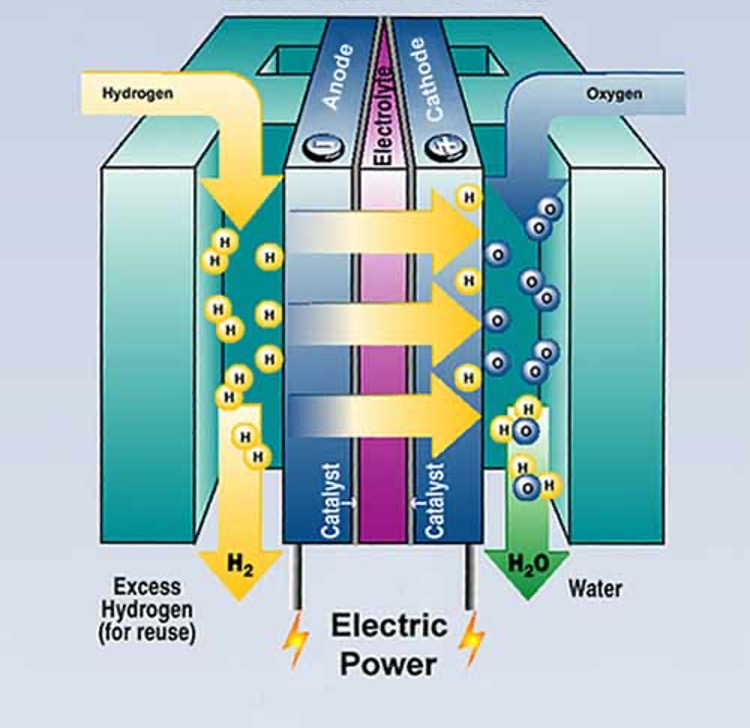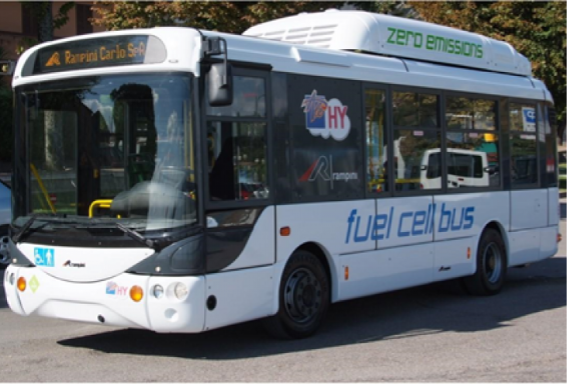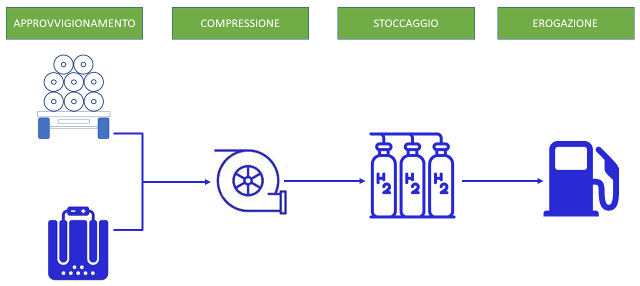
Hydrogen in mobility
Nowadays, the search for solutions focused on low environmental impact in vehicular transport is becoming increasingly important both from an economic and a technical point of view. The hybridization of zero-emission technologies that can, thanks to their complementarity, overcome the intrinsic limits of each is therefore interesting.
In this context, it is interesting to underline how there is increasing interest in the transfer of fuel cell technology, already analyzed for residential and industrial plants, in automotive applications and specifically in hybrid electric solutions. Among the various types of fuel cells available for use in vehicle systems, according to the technical literature, proton exchange membrane (PEM) fuel cells are the most promising due to their high power density and low operating temperature.

Considering the technological characteristics both of fuel cells (FC) and batteries, integration and interaction of those components in Mobility applications is a trump card. In fact, considering the power load request of a vehicle (starting, acceleration, load variation), an integrated FC system with a battery system, constituting a hybrid power supply system, was analyzed.
Hydrogen road mobility and technology used in LIFE3H project
The zero-emission buses for transporting people characterized by an innovative hybrid propulsion system based on the hybridization of two green technologies such as hydrogen, via fuel cell, and electric, with battery storage, will allow, thanks to the adoption of these two complementary technologies, to overcome the limits of pure Electric technology with a strong impact in the Local Public Transport (LPT) sector.
In fact, the current distances, considering an average urban route, supported by battery power alone do not currently guarantee the entire service if not to the detriment of on-board comfort (reduction of auxiliary services such as air conditioning) or time coverage of journeys due to the inclusion of charging shifts during service which however alter the original mission profile (autonomy problem).
With the inclusion of the hydrogen-based hybrid component, whose refueling times are comparable to little more than a refueling of a simple diesel bus, it will be possible to overcome the limits listed above making the vehicle equivalent to zero emissions, in terms of mission targets, to the diesel bus model.
In fact, the simultaneous presence of these two energy sources on board and their coordination allows numerous advantages: first of all is the reduction in the size of the battery pack, which compared to a traditional electric bus are now equal to half or a quarter. As a result of this reduction, there is an overall reduction in the weight of the vehicle, allowing the transport of more people.
The introduction of hydrogen on board, stored in gaseous form in special tanks, not only replenishes the removed energy component but often increases it significantly; moreover, it allows to optimize the use of residual batteries by extending their useful life with beneficial effects also at the level of circular economy

Here is how, through the integration and management of the two energy sources, the intrinsic limits of the pure battery vehicle can be overcome thus allowing:
- reduced charging times,
- reduced refueling times,
- equivalent performance with much longer distances,
- transport of multiple passengers,
- better on-board comfort by increasing the power of the air conditioning and heating units.
HRS
The HRS (Hydrogen Refueling Stations) are modular infrastructures, made up of several interconnected elements, to guarantee the supply of hydrogen, gaseous or liquid, to serve mobility.
The basic modules are the compressor, storage (at different pressures) and the dispenser; normally the first two components are positioned in a specific fenced technological area, while the dispenser, mechanically connected a special underground high pressure piping, is positioned so as to be easily usable by the refueling vehicles.
The supply of the gaseous molecule can take place by transport with a tube trailer, through a hydrogen pipeline or by on-site production (electrolysis or steam methane reforming).
Subsequently, the compression system, which can be realized with different technologies (piston, membrane, ionic, etc.) and with multiple stages, is used to compress the hydrogen starting from 20 bar of production through electrolysis or from about 200 bar of the tube trailer, up to the target pressure required by the system (350 or 700bar)
After compression, there is a storage made by one or more tanks, at different pressures based on the compression stages, and made of different materials such as steel or fiber-composite, sized to ensure optimal supply of the vehicles.
The compressed and stored hydrogen is then cooled, depending on the ambient temperature, the delivery temperature of the fuel and the target pressure in the vehicle tank, so that it can be subsequently supplied in the vehicle while remaining within the limit values of the on-board storage system. The dispenser, consisting of a hose that connects to a receptable placed on the vehicle, monitors, through a display, the quantities of product introduced into the vehicle.

All components are controlled by a PLC (programmable logic controller) which allows you to monitor the various parameters (pressures, temperatures, operating logics, active safety systems, etc.) even remotely.
The system, designed according to the current Firefighting legislation, is sized to guarantee optimal refueling performance according to the customer’s needs, and is modular, to allow upgrades ad demand changes.



